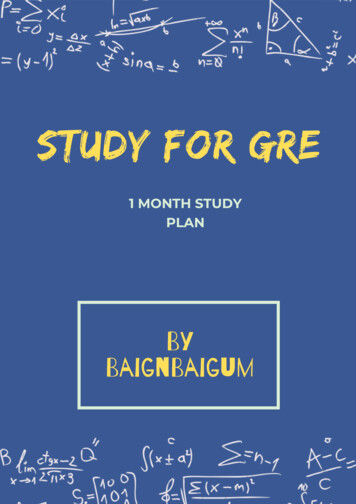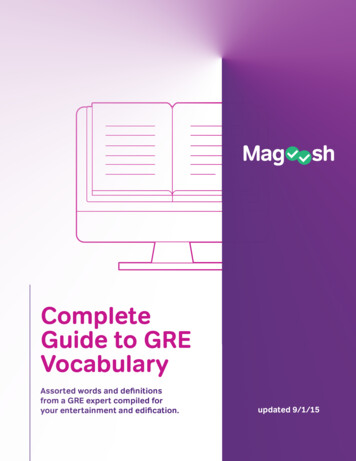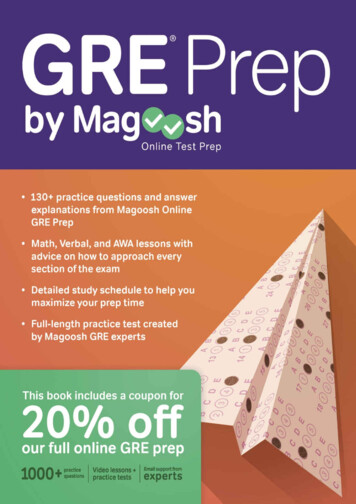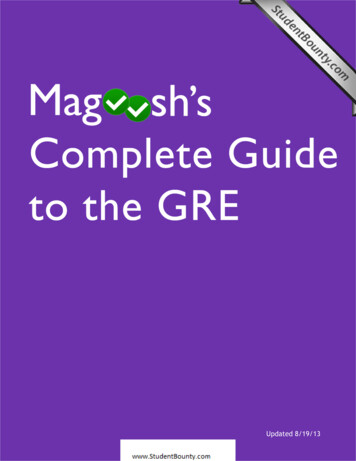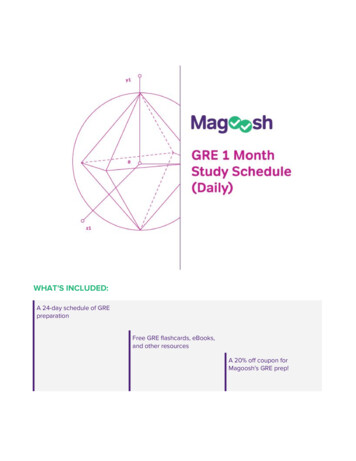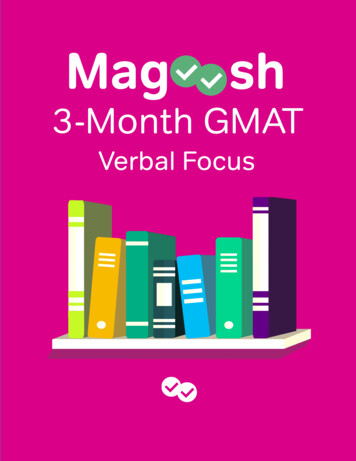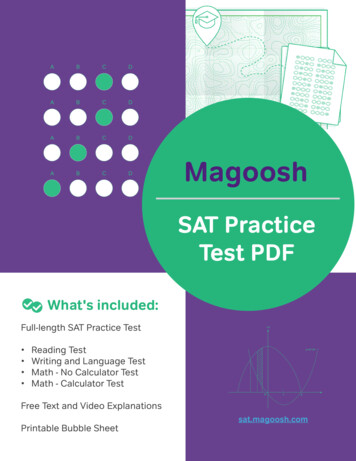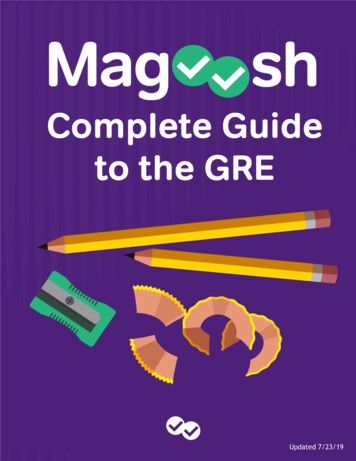
Transcription
Updated 7/23/19
Table of ContentsIntroductionThe Magoosh TeamAbout UsWhat is Magoosh?Featured inWhy Our Students Love UsMeet the Revised GREBreakdownHow is the Revised GRE Scored?Adaptive NatureThe Quantitative SectionQuestion Types: Multiple ChoiceQuestion Types: Multiple Answer Questions (MAQs)Question Types: Numeric EntryQuestion Types: Quantitative ComparisonPacing StrategiesCalculator StrategiesMath Formula Cheat SheetBasic Concepts: AlgebraBasic Concepts: Combinations and “Permutations”1gre.magoosh.com
Basic Concepts: ProbabilityBasic Concepts: FactorialsBasic Concepts: Data InterpretationPractice QuestionsVerbal SectionQuestion Types: Text CompletionsQuestion Types: Sentence EquivalenceQuestion Types: Reading ComprehensionQuestion Types: Argument Questions (Critical Reasoning)Pacing StrategiesVocabulary: Learning in ContextVocabulary: Magazines and NewspapersPractice QuestionsAnalytical Writing AssessmentThe Argument EssayThe Issue EssayResourcesStudy PlansOfficial Practice Material from ETSBook Reviews2gre.magoosh.com
IntroductionThis eBook is meant to serve as an introduction to the revised GRE and combines information from some ofthe most popular posts on the Magoosh GRE blog. If you’re new to the GRE, and want to know what to expectand how to prepare, this eBook is for you!If you’re already familiar with the exam and are looking for in-depth study material, head over to theResources section.The Magoosh TeamE-mail us at support@magoosh.com if you have any questions, comments, or suggestions!3gre.magoosh.com
About UsWhat is Magoosh?Magoosh is online GRE Prep that offers: Over 200 Math, Verbal, and AWA lesson videos. That’s over 20 hours of video!Over 1000 Math and Verbal practice questions, with video explanations after every questionMaterial created by expert tutors who have in-depth knowledge of the GREE-mail support from our expert tutorsCustomizable practice sessions and mock testsPersonalized statistics based on performanceAccess anytime, anywhere from an internet-connected device4gre.magoosh.com
Featured inWhy Our Students Love UsThese are survey responses sent to us by students after they took the GRE. All of these students andthousands more have used the Magoosh GRE prep course to improve their scores:5gre.magoosh.com
6gre.magoosh.com
7gre.magoosh.com
Meet the Revised GREBreakdownThe SectionsThe Revised GRE will consist of two Verbal sections, two Quantitative sections, and one experimental section,which can be either Verbal or Quant. The experimental section will not count towards your score. You willreceive an overall Quantitative score in the 130 to 170 range, and an overall Verbal score, also from 130 to170. Thus, the Revised GRE is out of 340.Number of questions and time limitFor the computer-based exam, the Verbal sections contain 20 questions each. You will be given 30 minutes tocomplete each section. The Quantitative sections also consist of 20 questions each, but you will have 35minutes to complete each section.The Quantitative SectionsThe Quantitative section is made up of about 7 Quantitative Comparison Questions and 13 non-QuantitativeComparison questions (a majority of which will be Multiple Choice, with a few (1-2) Numeric Entry andMultiple Answer questions each).Multiple Choice is pretty standard—you’ll just have to identify the one possible correct answer.Multiple Answer can have up to 10 answer choices, and you’ll have to “select all that apply”, which means thatthe number of correct answers is also unknown.Numeric Entry is an open-ended question type in which you will have to type in the correct value.Quantitative Comparison will list two quantities, A and B (anything from algebraic expressions to the sidelength of a given geometric shape) and ask you to compare them and select one of the following: A is equal toB, A is greater than B, A is less than B, or that the relationship between the two quantities cannot bedetermined from the information given.Additionally, there is a basic on-screen calculator that you will have access to during the Quantitative sections.8gre.magoosh.com
The Verbal SectionsThe Verbal Section is made up of about 6 Text Completions, 4 Sentence Equivalence questions, and 10 ReadingComprehension questions.Text Completions can have one to three blanks, and range from short sentences to a four-sentenceparagraphs. For two- and three-blank Text Completion questions, you must answer each blank correctly toreceive full points—no partial credit!Sentence Equivalence questions have six possible answer choices. For every Sentence Equivalence question,there will be two correct answers. To receive any credit you must choose both correct answers.Reading Comprehension passages range from 12 to 60 lines. Topic matter is usually academic in nature andcovers areas such as science, literature, and the social sciences. Question types include standard multiplechoice questions, highlight the passage questions, and multiple-answer questions, which require you tochoose any one of three possible answer choices.The Writing SectionTo begin the test, there are two essays, and you’ll be given 30 minutes for each: The Issue and The Argument.Neither is part of your 130 – 170 score. Each essay receives a score ranging from 0 – 6. Your final essay score isthe average of both essay scores.We have in-depth examples and strategies for each section later in this book.9gre.magoosh.com
How is the Revised GRE Scored?The Revised GRE scale may seem pretty arbitrary. After all, who has ever been graded on a test from 130 –170? Not that the 200 – 800 scale was standard, but, still, there was a certain panache in being able to say, “Igot an 800!” (a 170 sounds far from perfect). And, just to clarify, both these scales apply to the verbal sectionand math section, so, technically, the new GRE is out of 340 (which sounds just as awkward).So, why the strange range (pardon the rhyme)? Well, according to ETS, they wanted to stick to three digits sothat the colleges wouldn’t have to overhaul all the textbox entries that call for three digits. Fair enough. Also,to avoid confusion with the current scoring system, ETS made sure the two score ranges didn’t overlap (hadthey made the new GRE out of 200, then a person who’d gotten that score on the current GRE would suddenlylook a lot smarter if they were to say a few years from now, “Hey, I got a 200 on the GRE verbal section”).On the surface, the new GRE scoring range appears to be more limited than that of the current system. Afterall, 200 – 800, based on 10-point intervals, allows for only a 61-point spread, compared to the new GRE’s 41point spread, based on one-point intervals. The new GRE makes up for this more limited range by giving moresignificance to the extreme ends of the scale. For example, on the current GRE, there really isn’t muchdifference between 730 and 800 on the verbal—they are both in the 99th percentile range. On the new GRE,the difference between 165 and 170 will be the 99th percentile vs. the 96th percentile.At the end of the day, you are not going to be tested on these statistical nuances. The important thing toremember is that many colleges base their rankings on a percentile score, which you will also receive as partof your score report.10gre.magoosh.com
Adaptive NatureOn the old GRE, the test adapted within each section. The computer would assume that every test taker wasequal and would typically start with a mid-range question. If the test taker answered a few questions correctly,the test would become progressively difficult. And if the test taker answered the questions incorrectly, thetest would become progressively easier.The old GRE algorithm is slightly more nuanced than this, but really the details, at this point, are moot. Weonly care about the Revised GRE.The Revised GRE adapts between sectionsA salient difference between the old GRE and Revised GRE is that the Revised GRE has two sections for Mathand two sections for Verbal. The old GRE had one section for each. That the Revised GRE has two sections foreach subject is significant—this allows ETS to make the test adapt between sections.There is no adaptation within sectionThe section adaptation is the only adaptation that happens on the Revised GRE. What this means is that thequestions do not change depending on whether you answer them correctly. Think of it this way – each sectionis static. Your performance on the first section will determine whether you get an easy section or a difficultsection. The easy section is static and the difficult section is static. Again, this means the questions in thesection do not change. You could miss the first ten and question 11 will still be question 11; you could workbackwards from the last question, nailing all of them, and question 11 is still question 11.The level of difficulty of questions is randomEven though a section is static it doesn’t mean that, theoretically, it couldn’t become progressively harder.After all, this is what the old old GRE (meaning the paper-based 1990 GRE) was like. However, there is noorder of difficulty on the Revised GRE. The first question can be the hardest and the last question the easiest.Each question is weighted the sameDo not spend 5 minutes trying to answer the question in which four circles are wedged inside some octagon(actually, that would make an interesting question – but another time!). Each question is basically weighed thesame. So the question that gives you the radius and asks for the area, which should take no more than 15seconds, is worth the same as the one about the monstrous polygon.Can you let up at the end?11gre.magoosh.com
Again, each question is weighted the same – and the computer hasn’t “figured you out” the way it supposedlydid with the old GRE. Your score on the Revised GRE is based on how many questions you miss. The point hereis that you do not reach a certain level in which the computer “thinks” you are doing very well (à la the oldGRE). So do not slack off at the end, thinking you answered most questions correctly and now you’re set.The only reason I even mention this – as it is counterintuitive – is because many are still operating under theconception of the old GRE, in which you could, at least somewhat, slack off at the end without hurting yourscore too much.Takeaways The Revised GRE does not adapt within a section, only between sectionsEach question is weighted the sameDifficult questions and easy questions are randomly mixed throughout the section12gre.magoosh.com
The Quantitative SectionQuestion Types: Multiple ChoiceJust a regular multiple choice question, with only one right answer! Here’s an example—try it out for yourselfbefore checking the explanation below.Which of the following equations is true for all positive values of x and y?Answer and Explanation:13gre.magoosh.com
14gre.magoosh.com
Question Types: Multiple Answer Questions (MAQs)The new GRE is officially calling these Multiple Choice Questions: Select One or More Answers. For brevity—and clarity’s sake—I’m going to call them MAQs: Multiple Answer Questions.Doesn’t sound too complicated? Well, I could ask you to imagine a question that has ten possible answerchoices, any number of which could be correct. Or, I could just ask you to turn to page 123 of the ETS RevisedGRE book, for those of you who’ve already picked up a copy.Those well-versed in their combinations/permutations problem know the chances of guessing correctly on thisquestion is 1 in 1,023, odds so slim the question might as well have been a big empty fill-in the blank (yeah,the Math section has those too).I’m probably making the Quantitative MAQ’s sound scarier than they actually are. Most will probably onlyhave five or six possible answer choices, not ten. The bottom line: if you know the concept being tested, andare careful and methodical, then you should be able to get this cumbersome question type correct.Here is an example of an MAQ that I think you should definitely be capable of getting right if you’re careful:If n is a two-digit number, in which n xy. If x y 8, and x and y are positive integers greater than 1,then the units digit of n could be which of the following?A.B.C.D.E.F.G.H.I.J.0123456789As a side note, on the actual Revised GRE, each answer choice will have a square around it. When you see the15gre.magoosh.com
square you know you’re dealing with Multiple Answer Questions. If there is a circle around the answer choice,then it is business as usual—one answer only.As for the question above, the answers are B, C, E, F, G, and H.If you missed the question, remember that x y has to be less than 8. Also, make sure you write somethingdown when tackling Multiple Answer Questions. Trying to juggle all the information in your head will surelyget you in trouble.Question Types: Numeric EntryTwo trains starting from cities 300 miles apart head in opposite directions at rates of 70 mph and 50mph, respectively. How long does it take the trains to cross paths?This is a classic problem that sends chills up students’ spines. I’m now going to add another bone rattlingelement: The Empty Box.That’s right—the GRE will have fill-in-the blank/empty box math problems, called Numeric Entry. There won’tbe too many, judging from the ETS Revised GRE book, but even a few should be enough to discomfit most.Let’s go back and attack the above problem the following way. When you have any two entities (trains,bicyclists, cars, etc.) headed towards each other you must add their rates to find the combined rate. The logicbehind the combined rate is the two trains (as is the case here) are coming from opposite directions, straightinto each other.This yields 120 mph, a very fast rate (which accounts for the severity of head-on collisions don’t worry, thetrains in the problem won’t collide!).To find the final answer, we want to employ our nifty old formula: D RT, where D stands for distance, Rstands for rate, and T stands for time.We’ve already found R, which is their combined rate of 120 mph. They are 300 miles apart so that is D.Plugging those values in, we get 300 120T. Dividing 120 by both sides, we get T 2.5 hrs.Now we can confidently fill that box in, and let the trains continue on their respective ways.16gre.magoosh.com
Question Types: Quantitative ComparisonQuantitative Comparison (QC) is a huge part of the GRE, roughly one-third of the Quant section. Often, whenprepping, you may forget this fact and spend much more time on problem solving. Quantitative Comparison isa unique beast—while the math concepts are the exact same as those covered in Problem Solving, QC can bevery tricky. In fact, the test writers work very hard to make these questions seem very straightforward. Yet,there is usually a trap or twist, waiting to ensnare the unsuspecting test taker.The format will always be the same: comparing two quantities (Column A vs. Column B), with the same 4answer choices that evaluate the relationship between the two quantities. However, the quantities forColumn A and B can be anything from expressions with variables to references to a quantity in a geometricshape.Column AThe number of positive multiplesof 49 less than 2000Column BThe number of positive multiples of 50less than or equal to 2000The quantity in Column A is greaterThe quantity in Column B is greaterThe two quantities are equalThe relationship cannot be determined from the information givenThe ApproachFirst off, we must understand what a multiple is. A multiple is any number that results when multiplying aninteger, x, by 1, 2, 3, 4 If x is equal to 5, then the multiples of 5 would be:5x1 55 x 2 105 x 3 155 x 4 205 x 5 255 x 6 30 17gre.magoosh.com
From the table above, we can see that any multiple of 5 is divisible by 5. For instance, 1000/5 200. Therefore,1000 is a multiple of 5.The question above asks us how many multiples of 49 are less than 2000. We can divide 2000 by 49 to seehow many multiples of 49 are less than 2000. Doing so may take a while. A faster way is to note that 49 is veryclose to 50. Quick math allows us to determine that 50 x 40 is 2000. Therefore, 49 x 40 equals 40 less than2000, or 1960. If we were to multiply 49 x 41, we are adding 1960 49, which takes us to 2009. This is greaterthan 2000. Therefore, we know that there are only 40 multiples of 49 less than 2000.What about column B? Well, we’ve already figured out that 40 x 50 equals 2000. But, here is the tricky part.Whereas Column A stipulated that the number has to be less than 2000, Column B says the number has to beless than OR equal to 2000. Therefore, there are 40 multiples of 50 that are less than or equal to 2000. (Iwrote this question, and I know it is evil. But sneakily adding a couple of words that changes the answer is aclassic trick employed by the writers of the test).Answer: C.First InstinctsThere is a good chance that your first instinct was A. Clearly, 49 is lower than 50, so it has to have moremultiples. Usually, when the answer to a Quantitative Comparison question appears obvious at first glance,there is some twist to the problem. In this case, the twist was the wording in Column B: less than or equal to2000. So, be wary of any QC questions that seem too easy. Look for a twist or a trap.18gre.magoosh.com
Pacing StrategiesEach math section contains 20 questions. You are given 35 minutes for each section, which works out to 1:45minutes per question. Below are some helpful tips to help you wisely use these 35 minutes.Go for the low hanging fruitEach question in the GRE quantitative section is worth the same number of points. That is such an importantpoint that I am going to repeat it again (in caps): EACH QUESTION ON THE GRE SECTION IS WORTH THE SAMENUMBER OF POINTS.That’s right, folks. If ETS devised a question such as the following:The five minutes you’d take to (maybe) answer the question correctly will yield the exact same number ofpoints as this question:If, what is the value of x?So what’s the takeaway from this? Other than, “Factorials scare the living expletive out of me!”?Well, why waste time on a very difficult question when you can simply scroll to an easier question? Think of itthis way: in 35 minutes you want to score as many points as you can, and each question is worth the same.If I paid you 1,000 dollars for every apple you picked from a tree in 35 minutes, what would you do? Youwould go for the low hanging fruit. You would not waste your time climbing to the very top of the tree to pluckan apple that is worth the same amount of money as an apple that you can simply reach out and grab withboth your feet planted on the ground.Of course, after a certain point—that is to get a high score—you must grab the fruit up on high, and go for thedifficult questions. But make sure you’ve answered the easy ones first.How much time should I budget per question?The answer differs depending on how difficult the question is. Think of it this way. There are easy questions,medium questions, and difficult questions. Easy questions should take between 45 seconds and 1 minute.Medium questions should take between 1:00 – 2:00. And difficult questions should take no longer than 319gre.magoosh.com
minutes. The ratio of easy, medium, and difficult questions vary per section but in general you can expect tosee a smattering of each. On the easy section, the ratio will skew towards easy; in the difficult section thatratio will skew towards difficult.Learning to let a question goIf you are staring at a question and have been unable to devise a solution after a minute, you should seriouslyconsider moving on to the next question. Again, keep the low-hanging fruit metaphor in mind.If, however, you are dealing with a difficult math question (and it is clear that it is difficult, and you’re not justmissing something obvious), then take a couple of minutes, as some questions will clearly take that muchtime. Do not freak out on a question that is clearly convoluted just because you’ve taken 2 minutes. As long asyou are headed toward the solution, persevere.Do not be sloppy but do not obsess over easy questionsUsing the time schematic above, we can see that easy questions can take less than a minute. It is important toanswer these questions confidently and move on. If you dither, then that is time that could be spent on amore difficult question. However, do not race through an easy question, because then it defeats my wholelow-hanging fruit sermon—missing a question that you could easily have answered correctly had you spentthat extra second does not make sense (especially if you are racing towards difficult questions that you maynot even answer correctly in the first place).Make sure you guessYou do not even have to approach every question, especially the difficult ones, as I mentioned above. Butmake sure at the very end that you guess on any questions remaining, because there is no penalty forguessing. So if you’ve been skipping a lot of questions, give yourself enough time at the end to bubble in thequestions you left blank. A little bit of luck can go a long way!20gre.magoosh.com
Calculator StrategiesFor many students, the addition of the GRE’s onscreen calculator to the new exam is a godsend. Thesestudents take solace in the notion that this new calculator will help them solve tons of questions. The truth ofthe matter is that almost all math questions on the Revised GRE can be solved without a calculator.Furthermore, in many cases, it will actually take longer to solve a question using a calculator that it will to useother techniques. Finally, the test-makers are taking questions that can be easily solved with a calculator andchanging the numbers in order to render the calculator useless.For example, a former GRE question would have asked you to evaluate–. The slow solution was toperform the actual (tedious) calculations. The fast solution was to recognize that this difference of squares canbe factored as, which equals, which equals.Since this question would be too easy to solve using the onscreen calculator, the test-makers will change thequestion towhereandhave too many digits for the calculator to handle. Assuch, you’ll have to solve this question using factoring techniques.Aside: the onscreen calculator displays up to eight digits. If a computation results in a number greaterthanthen an ERROR message is displayed. When you evaluateyou get a 9-digit number.Now, despite the test-makers’ attempts to remove the calculator from your arsenal, there are times when youcan make a few adjustments to a question and then quickly answer it with the calculator.We can solve the following question using a variety of techniques and strategies:Column AColumn BThe quantity in Column A is greaterThe quantity in Column B is greaterThe two quantities are equalThe relationship cannot be determined from the information givenNotice that these numbers yield products that are too big for the calculator to handle. However, with a fewadjustments we can use a new strategy with the calculator to answer the question.One solution is to first divide each column by 1,000,000. When we do this, we get:21gre.magoosh.com
Column AColumn BFrom here, we can rewrite this as:Column AColumn BAnd this is the same as:Column AColumn BAt this point, we can use the calculator enter all of these values, and each resulting product will have fewerthan 8 digits.So, with a small modification, we can answer this question using a calculator.Now, can you think of another approach that allows you to use a calculator to solve the original question(without dividing by 1,000,000 or any other powers of 10)?Here’s the original question:Column AColumn BAnother approach is to first divide both sides by 641,713 to get:Column AColumn B22gre.magoosh.com
Then, divide both sides by 897,189 to get:Column AColumn BAt this point, we can enter all of these values into the calculator and compare the columns.Next, we’ll examine another strategy to thwart the Revised GRE and use the onscreen calculator to solvequestions that, at first glance, appear to render the calculator useless:The square root of 2 billion is between2,000 and 5,0005,000 and 15,00015,000 and 30,00030,000 and 50,00050,000 and 90,000Try to identify at least two ways to solve the above question.Aside: Please notice that 2 billion is too large to fit in the onscreen calculator.Non-calculator strategyThis approach uses the following rule:23gre.magoosh.com
First, we need to recognize that:From here, we can see that sincewe can say thatIfandthenmust lie between 4 and 5. In other words,equals 4.something.equals 4.something, thenmust lie between 40,000 and 50,000.As such the answer must be D.Calculator strategyWith a slight modification, we can use the onscreen calculator to solve the question within seconds.First recognize that:From here we can use the calculator to evaluate both roots. When we do this, we get:So, the answer must be D.Math Formula Cheat SheetWhile this is a very useful cheat sheet, do not just memorize formulas without actually applying them to aquestion. Often students will see a question and will assume that a certain formula is relevant. This is not24gre.magoosh.com
always the case. So make sure you practice using the formulas so you will know when they pertain to aquestion.InterestSimple Interest:Compound Interest:, where P is principal, r is rate, and t is time, where n is the number of times compounded per yearWork RatesSetsDistance, Rate, and Time,Circles25gre.magoosh.com
Squares, where s sideRectangles, where l length and w widthTrapezoidsPolygons, where n # of sidesThe Distance FormulaPrime numbers and integers1 is not a prime. 2 is the smallest prime and the only even prime.An integer is any counting number including negative numbers (e.g. -3, -1, 2, 7 but not 2.5)Fast Fractionsi.e.26gre.magoosh.com
Divisibility3 : sum of digits divisible by 34 : the last two digits of number are divisible by 45 : the last digit is either a 5 or zero6 : even number and sum of digits is divisible by 38 : if the last three digits are divisible by 89: sum of digits is divisible by 9Combinations and Permutationsn is the total number, r is the number you are choosingProbability27gre.magoosh.com
Basic Concepts: AlgebraThe FOIL method is one that almost everybody remembers learning at some point, circa middle school.Though you may have forgotten the details, with a little practice, you should be able to use it effectively.First off, FOIL stands for First, Outer, Inner, and Last, and refers to the position of numbers and/or variableswithin parenthesis. Let’s have a look:Remember when parentheses are joined together, there is an invisible multiplication sign. The tricky part ishow to multiply together a bunch of x’s and y’s. The answer: the FOIL method. F (First): The first term in each parentheses is x, so we multiply the x’s together to get:O (Outer): The term on the outside of the left parenthesis is ‘x’ and on the outside of the rightparenthesis is ‘y’. We multiply the two together to get:. I (Inner): Now we multiply the inner terms in each parenthesis: L (Last): Finally, we multiply the terms that are the rightmost to getNow we add together our resultsSo.Memorize this pattern. Do not spend time on the test actually completing the steps above.Other important algebraic expressions to memorize are:.Here are some examples in which we apply the above.A.B.C.28gre.magoosh.com
Other applications of FOILThese questions appear as though they would not relate to the FOIL method. But upon closer inspection, wecan see that these numbers aren’t random.If we add them, instead of multiplying, we get 200, for the first question, and 160, for the second.Orand.Let’s focus on the pair of hundreds:Notice thatvs.can be written astheform, which expressed correctly isSolving in this way is much more effective, becauseyour head. Now you should see., a number you should know off the top ofOther TipsCompare the following:vs.In the first case, there are two solutions: 0 and 4. Remember when you square a negative number, asin, you get a positive number.With the equation on the right side, the one in which x is under the square root sign, if you get a negativenumber, you cannot take the square root of it (at least in GRE world, where imaginary numbers do not comeinto play).29gre.magoosh.com
In the case of, we square both sides to get, so.Basic Concepts: Combinations and “Permutations”Whenever I see a GRE resource label its counting section as “Combinations and Permutations,” a small part ofme dies a little. Okay, that’s an exaggeration, but I am concerned about the misleading message that this sortof title conveys. To me, it suggests that counting questions can be solved using either permutations orcombinations, when this is not the case at all. The truth of the matter is that true permutation questions areexceedingly rare on the GRE.Now, for those who are unfamiliar with permutations, a permutation is an arrangement of a subset of items ina set. To be more specific:If we have n unique objects, then we can arrange r of those objects inways, whereequals someformula that I still haven’t memorized even though I took several combinatorics courses in university, and Itaught counting methods to high school students for 7 years.Now, it’s not that the permutation formula is too complicated to remember; it’s just that it’s unnecessary tomemorize such a formula for the GRE. In my humble opinion, the permutation formula has no place in a GREresource (even though the Official Guide covers it).Here’s an example of a true permutation question:Using the letters of the alphabet, how many different 3-letter words can be created if repeatedletters are not permitted?Here, we have a set of 26 letters in the alphabet, and we want to determine the number of ways wecan arrange 3 of those letters. So,
gre.magoosh.com 3 Introduction This eBook is meant to serve as an introduction to the revised GRE and combines information from some of the most popular posts on the Magoosh GRE blog. If youre new to the GRE, and want to know what to expet and how to prepare, this eBook is for you!
